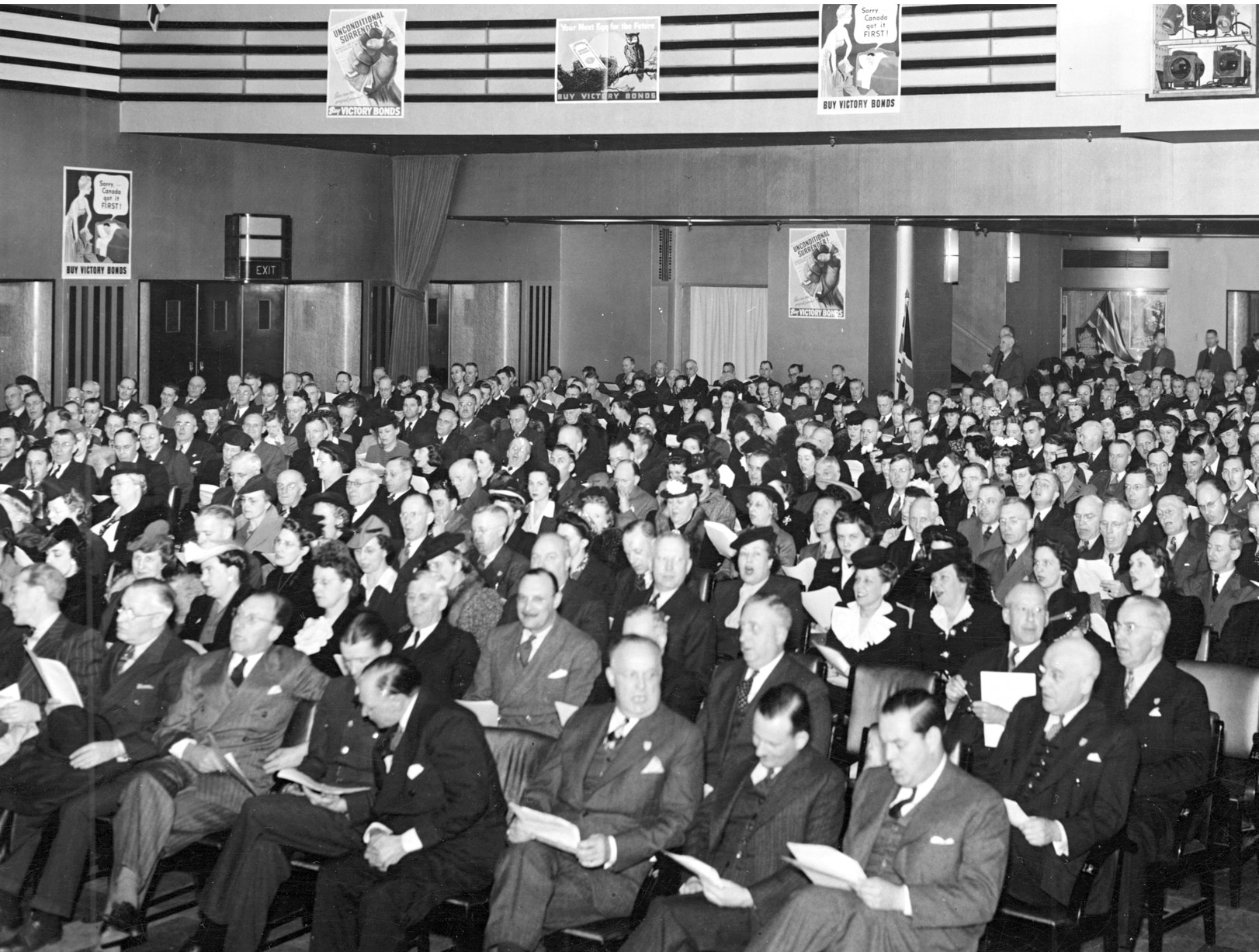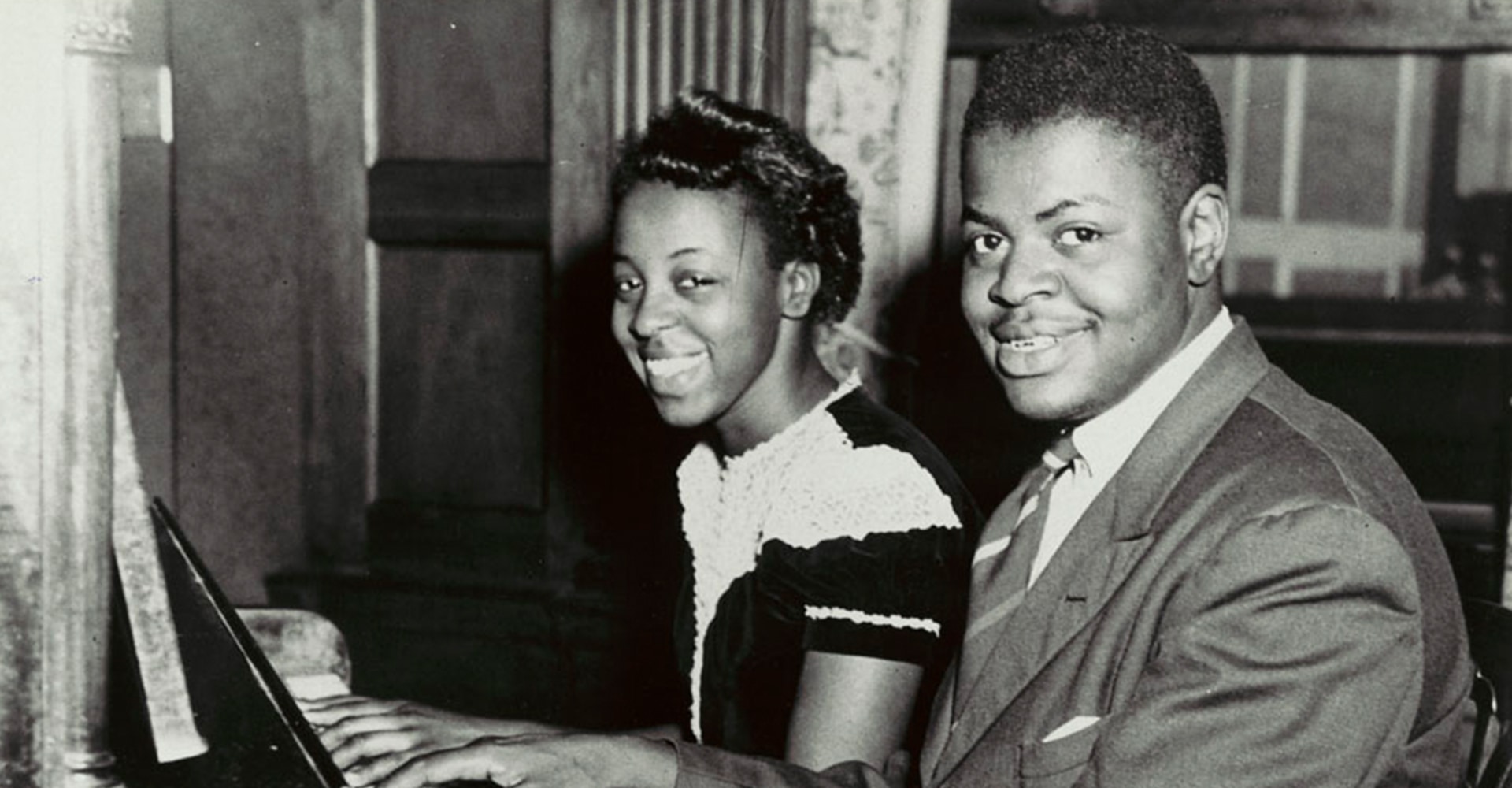
Born and raised in the Beach community of east Toronto, Glenn Gould (1932–1982) found personal and professional expression through his instrument: the piano. Above all else, Glenn Gould was an individual. His playing style was unique, his choices of musical piece unexpected, and his interpretations creative.
Few performers sought to communicate with his audiences the way he did. Gould brought something new to everything he touched.
Gould’s performances have been adapted into rock, jazz, and electronica. In 2018, violinist Andrew Forde explored Black Canadian identity via an interpretation of Gould’s music. Toronto-based collective Uninvited Guests created modern pop and hip hop remixes using samples of Gould’s recordings.
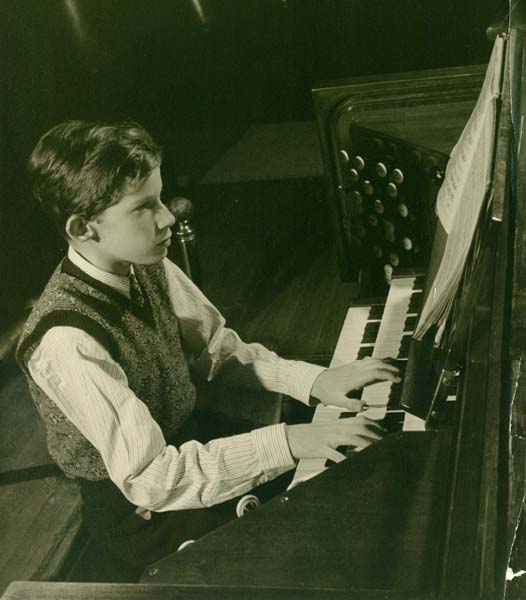
Glenn Gould playing the organ in the concert hall of the Toronto Conservatory of Music, circa 1945
Photo by Page Toles, Library and Archives Canada, Glenn Gould fonds, MUS 109-290, nlc-3749. Courtesy of the Glenn Gould Estate and the Royal Conservatory of Music
Striking the First Note of Success
Born in 1932 to a church-going musical family in the Beach community of Toronto, Gould began to play piano at the age of three with perfect pitch. Reading music before he could read words, Gould loved to practice and play piano.
Gould won first place repeatedly at the Royal Conservatory piano exams in his youth. Called "a brilliant young Toronto artist", Gould was on the road to success with exceptional technical skill. Critics hailed him as the next piano king.
A Young Animal Lover
Famed for his music, artistic genius, and eccentric personality, Glenn Gould was also known for his intense and lifelong love for animals. As a child, Glenn once tried to bring a skunk into his family's vacation cottage.
He affectionately named his animals after composers – Mozart, his budgie, and three goldfish named Bach, Beethoven, and Chopin. "By the time I was six," he once reflected, "I made an important discovery that I get along much better with animals than humans."
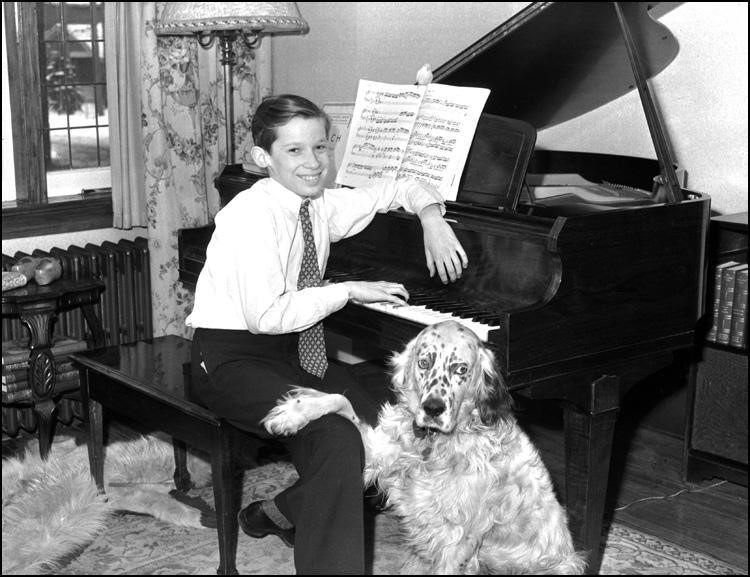
Glenn Gould as a child, at his piano with his dog Nicky, Toronto, ca. 1940.
Courtesy of Gordon W. Powley fonds C 5-1-0-133-2 Archives of Ontario, I0002768
The Eaton Auditorium
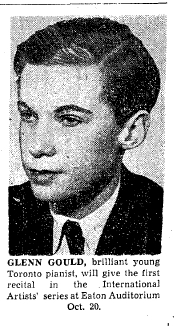
Toronto Daily Star, October 11 1947
Glenn Gould made his professional debut at the Eaton Auditorium in downtown Toronto when he was only 13 years old. Hailed by critics as a piano genius, Gould could be found on several other prominent Toronto stages, including Massey Hall during the late 1940s and early 1950s. Although Gould would eventually play stages all over the world, it was his first professional stage at Eaton Auditorium that became his favourite.
In his later years, Gould returned to the Eaton Auditorium to do most of his professional recordings, even after the Auditorium closed to the public in 1977.
A Record Deal
During one of his first professional tours, Gould played a concert at New York City's Town Hall in January 1955. The turnout was modest, but in the audience was a music reviewer for The New York Times, who applauded Gould's expressive playing and proclaimed the musician's New York debut “auspicious.”
Even more significant was the attendance of a representative of Columbia Records, who signed Gould to a record deal the very next day. It was the first time Columbia had signed a Canadian to a recording contract.
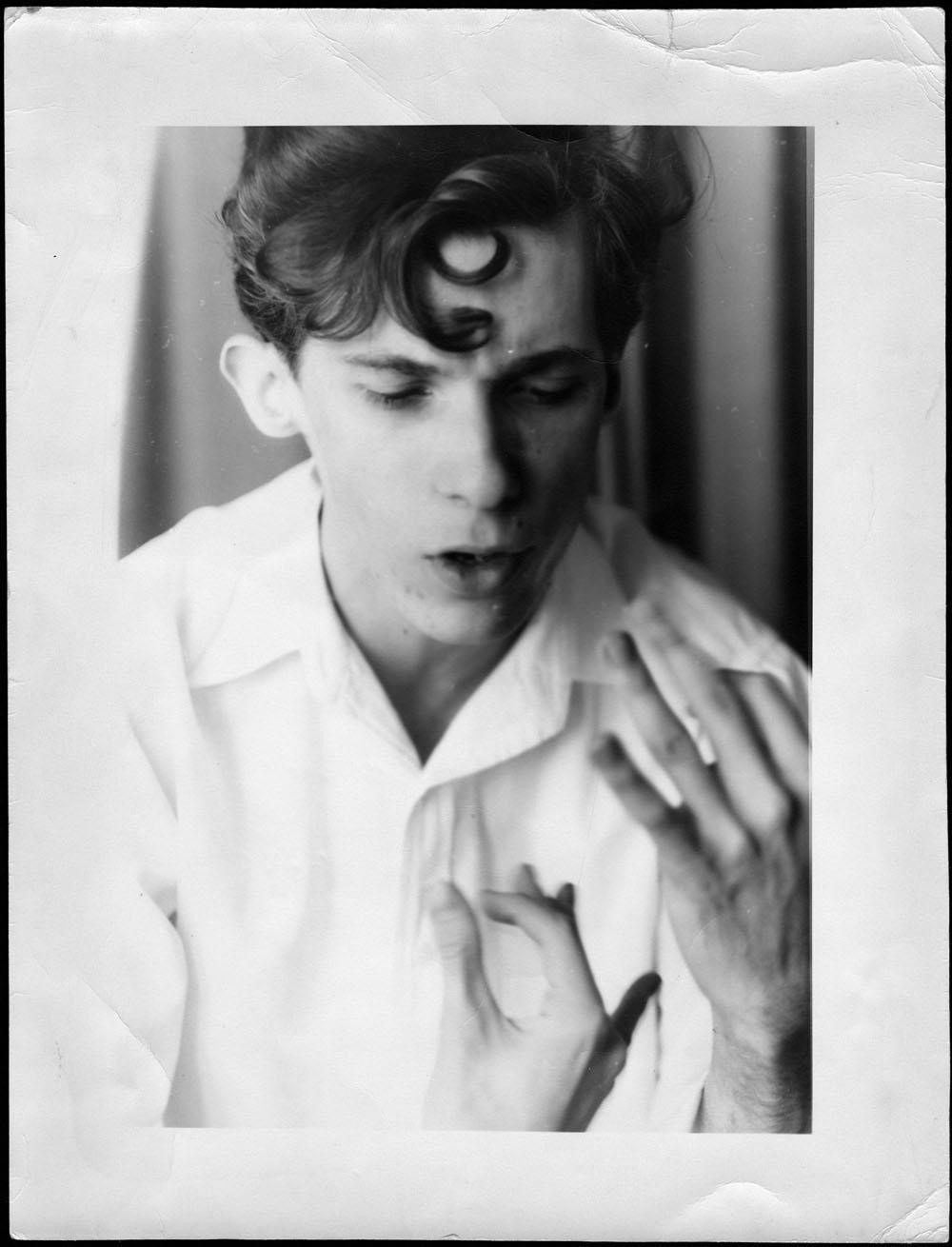
Portrait of a young Glenn Gould gesturing with his hands. Alongside with his musical talent Gould's mannerisms became a part of his artistic trademark that separated him from other pianists.
Photographer unknown, n.d. Library and Archives Canada, archival reference number R13915-1
Watch: The Goldberg Variations
In June 1955, Gould recorded his interpretation of Johann Sebastian Bach's Goldberg Variations. Originally written for a seventeenth-century harpsicord, Gould chose to reimagine the piece on the piano. Released in 1956, Gould's Goldberg Variations sold 40,000 copies in its first five years, an impressive amount for a classical recording. The recording catapulted the 24-year-old Gould to international fame and it remained his most recognized and celebrated recording for the rest of Gould's life.
This online exhibition uses third-party applications including Spotify and YouTube. Check with your organization’s web administrator if you are unable to access content from these channels in the exhibition.

Watch Glenn Gould break down some of the crucial parts and musical elements of Johann Sebastian Bach's Goldberg Variations in a CBC broadcast in 1964. Glenn Gould had a unique style to engage with the audience, such as his lowered posture close to the keys and audible humming, helped to build the public's fascination with the young musician. Courtesy of the CBC. Please note: This third party video does not provide closed captions.
View Transcript[Glenn Gould sits at a piano in a recording studio.]
[Glenn Gould] In that music the main aspect of variation lay in the preservation of a certain sequence of intervals by a display of that sequence of intervals interlocking overlapping and combining at various distances and in differing textures. The constant factor was the interval substance itself and the variable factor were the harmonic propositions to which it gave birth. A Swellings piece was essentially vocal in its orientation and it really reminisced about the Renaissance manner of linear craftsmanship. But there's another type of baroque variation and that is that which derives from what is called a ground base figure. A sequence of notes which provide a foundation for a certain harmony which is constructed above them but which don't necessarily become integrated as theme or as melody with the composition itself in the sense that Swellings' motivic nucleus certainly did. And in contrast to spellings music this principle tends to favor instrumental rather than vocal styles of composition. It's this principle of variation which Sebastian Bach employs in his famous Goldberg Variations and I got to play now approximately one third of that work. In fact all nine of the variations which also happen to double as canons. It happens that every third variation in this 30 part work variations 3; 6; 9; so on these variations keep up a constant imitative dialogue among their upper voices. And with each successive variation of this type which are referred to as canonic variations the interval between the voices that are used canonically widens. The first of these canons has no interval separation at all. It's described as a unison Canon.
[Music]
And the gap between the intervals in the imitative parts gradually widens throughout the work until in variation number 27 which is the last of these cannons it's widened to a gap of 1/9 and this is the way it sounds.
[Music]
So throughout all these canonic variations the harmonic sequence of which they have to concur remains absolutely constant. It still pertains to those 32 notes which structure the base harmonies. And despite all of the intricacies of this kind of texture the canons are still designed so as to be responsible to the harmonic connotations of this 32 note sequence. And by being variativ both as a ground base structure and variativ as a linear canonic structure this marvelous piece provides evidence of that two-dimensional texture which was so singularly the Bach texture. That glorious fitting out of the new harmonic standards of his day with the majestic sonorities of vocal counterpoint which belonged to an earlier era. So here are the nine canonic variations from the Goldberg Variations preceded by their theme.
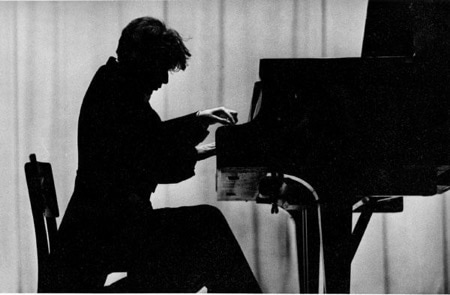
In 1957, Gould set out on a European concert tour that also included two weeks in the USSR. As the first North American pianist and first Canadian musician of any kind to play in the USSR since the death of Stalin in 1953, Moscow was thrilled. Concerts ended with cheers, tears, and endless encores.
Library and Archives Canada/Glenn Gould fonds/MUS 109-230 © Unknown. Reproduced with the permission of the Estate of Glenn Gould and Glenn Gould Limited. nlc-3795
Listen: The Goldberg Variations
If there’s any excuse at all for making a record, it’s to do it differently, to approach the work from a totally recreative point of view …— Glenn Gould, 1968
This online exhibition uses third-party applications including Spotify and YouTube. Check with your organization’s web administrator if you are unable to access content from these channels in the exhibition.
A Surprise Retirement
Gould, however, did not enjoy his concerts as much as his audiences, and retired from playing public performances at the age of 32. Never a fan of the mob-mentality of audiences nor of playing strange pianos in unfamiliar venues, Gould promptly stopped taking bookings for performances after the conclusion of his 1963-64 season. At the time, few realized that Gould's concert on April 10, 1964 in Los Angeles would be his last-ever public performance. During his entire professional career, Gould played fewer than 300 concerts.
Instead of performing publicly, Gould focused on working and recording with the CBC, creating radio programs to teach music to the public. Fascinated with technology, Gould contributed to CBC recital recordings, documentaries, and other programs. He considered these a more intimate way of communicating with the listener than by live performance. He not only embraced the potential of the media to transmit performances, but desired to push the media in new directions.
Listen: The Solitude Trilogy
Between 1967 and 1977, Gould produced a series of radio documentaries known as "The Solitude Trilogy." In each program, Gould explored audio layering techniques using multiple sounds. Glenn created what he called "contrapuntal radio" in which several people spoke simultaneously, forming an oral counterpoint.
Glenn Gould believed the future of music was electronic music. Believing the days of the live concert were limited, Gould envisioned a future where all music would be consumed via records, radio, and television.
This online exhibition uses third-party applications including Spotify and YouTube. Check with your organization’s web administrator if you are unable to access content from these channels in the exhibition.
At the centre of the technological debate, then, is a new kind of listener—a listener more participant in the musical experience...For this listener is no longer passively analytical; he is an associate whose tastes, preferences, and inclinations even now alter peripherally the experiences to which he gives his attention, and upon whose fuller participation the future of the art of music waits.
— Glenn Gould, “The Prospects of Recording”, High Fidelity, 1966
Gould's Final Years
Glenn Gould continued to record albums, television features, and radio broadcasts. In 1981, he returned to the music that had made his famous thirty years earlier: the Goldberg Variations. Unknown to him at the time, his 1981 recording of the Goldberg Variations would be his last recording for his long-standing label, Columbia Records.
Two days after his 50th birthday, Glenn suffered a massive stroke putting him into a coma. He died a week later on October 4, 1982. Gould's 1981 version of the Goldberg Variations went on to win the 1983 JUNO Award for a Classical Album and the 1983 Grammy Award for Best Instrumental Soloist Performance.
Well-Worn Soles
Reflective of his peculiar personality, Glenn Gould loosely laced his shoes, often a pair of oxfords, so he could slip them on and off as he pleased. Gould rarely polished his shoes and wore them in the rain, with mismatched socks, generally leaving his laces untied.
This pair of shoes was made by the Toronto company Matthew Dack Footwear. Its founder, Matthew Dack, emigrated from Ireland to Kingston, Ontario before moving to Toronto in 1834 – the same year Toronto became a city. Dack opened his first shop downtown at the corner of King and Jordan, and is recognized as one of Canada's oldest shoemakers and retailers, specializing in men's high-quality footwear.
This online exhibition uses third-party applications that may not be compatible with your current version of browser. Check with your organization’s web administrator if you are unable to access content from these channels in the exhibition, or try to access this webpage from another browser.
Keyboard controls: Use arrow keys to rotate the object and page up/page down to zoom.
Interact with this well-worn pair of Glenn Gould's shoes. Gould owned many similar pairs to these over his career, but wore this pair between circa 1978 and 1982, towards the end of his life. Collection of the Bata Shoe Museum, Toronto, Canada. L97.0002.A-D
A New Audience
In October 2020, in honour of what would have been Glenn Gould's 88th birthday, Toronto-based rapper and producer Billy Wild, in collaboration with several Toronto artists, released the album Uninvited Guests. The 9-track album offers a modern re-imagining of Glenn Gould's music, interpreted through the lens of diverse genres, ranging from hip hop to electronic music.
The result of a seven-year project from Toronto-based production house Division 88, Uninvited Guests began as an artistic collective to make Gould's piano recordings available as samples for hip hop or electronic remixes.
"[Gould] was the godfather of electronic music and nobody recognized that (…) the one thing that stuck out the most for us was - and this is what we built the entire project around - how he predicted that the audience will become the artist and the life will become the art."
– Billy Wild, producer, Uninvited Guests
Watch:
Uninvited Guests
Wishing to bring Gould's music recordings to a new audience, the collective artist project and 2020 album of Uninvited Guests reinterprets Gould's music and videos in a range of musical styles, one that continues Gould's passion for using technology to create music. Listen to how Uninvited Guests both preserves and reimagines Gould's classical recordings.
This online exhibition uses third-party applications including Spotify and YouTube. Check with your organization’s web administrator if you are unable to access content from these channels in the exhibition.

Courtesy of the estate of Glenn Gould, Primary Wave, Division 88, and Uninvited Guests. Please note: This third party video does not provide closed captions.
View Transcript[Music starts]
The video opens with a montage of Glenn Gould playing on the piano mixed with footage of present day musicians fine-tuning their equipment and playing on various instruments.
[Glenn Gould] I believe that the only excuse we have for being musicians and for making music of any fashion is to make it differently.
[Music continues]
The video continues with a montage of Glenn Gould playing on the piano mixed with footage of present day musicians fine-tuning their equipment and playing on various instruments.
A black and white colored logo appears depicting an insect.
Dive Deeper
Colin Eatock. Remembering Glenn Gould: Twenty Interviews With People Who Knew Him. Ontario: Penumbra Press, 2012.
Vladimir Konieczny. Glenn Gould: A Musical Force. Toronto: Dundurn Press, 2008.

